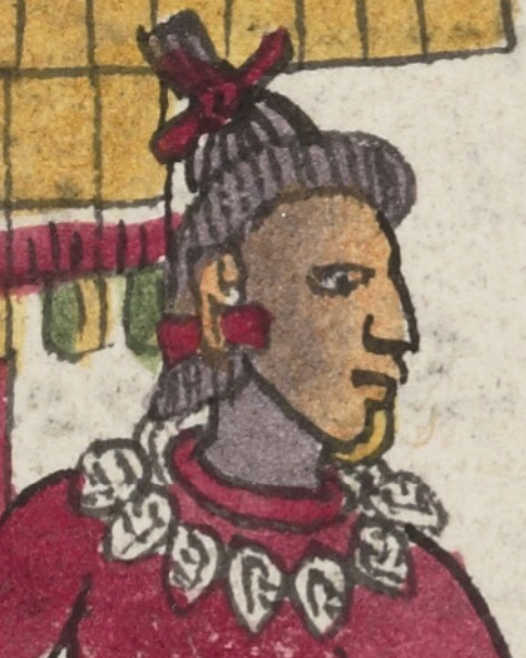teocuitlaacuechcozcatl (Mdz67r)
This iconographic example shows a shell necklace. In the contextualizing photo, we see that it is worn--by a man, apparently a type of priest--over a red garment. The shells are white and turbinate. Seven shells are visible. The thread, string, or thong that holds them together is not visible.
Stephanie Wood
We provide this necklace here as a comparison for other necklaces in the collection. TLACHIA and the study of the Codex Mendoza by Berdan and Anawalt (1992) give the spelling "teocuitlaacuechcozcatl," whereas it can also be seen spelled with just one "a" in the middle. The second "a" may add a water element. The element "cuech" in Nahuatl can also refer to moisture. Other smaller turbinate shells in this collection include the cilin (see below). The fact that these cuechtli shells were made into a necklace suggests that they are not the large conch shells that were used for trumpets.
Stephanie Wood
c. 1541, or by 1553 at the latest
Stephanie Wood
necklaces, collares, shells, caracoles
teocuitla(tl), gold, https://nahuatl.wired-humanities.org/content/teocuitlatl
cuech(tli), a long, spiral-shaped shell, https://nahuatl.wired-humanities.org/content/cuechtli
cozca(tl), necklace, https://nahuatl.wired-humanities.org/content/cozcatl-0
"Gold Shell Necklace"
el collar de caracoles de oro, o el "fleco de conchas en espiral"
Stephanie Wood; y P. Henning, https://mna.inah.gob.mx/docs/anales_/352.pdf
Codex Mendoza, folio 67 recto, https://digital.bodleian.ox.ac.uk/objects/2fea788e-2aa2-4f08-b6d9-648c00..., image 144 of 188.
Original manuscript is held by the Bodleian Libraries, University of Oxford, MS. Arch. Selden. A. 1; used here with the UK Creative Commons, “Attribution-NonCommercial-ShareAlike 3.0 License” (CC-BY-NC-SA 3.0)



